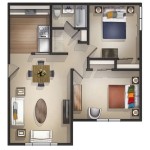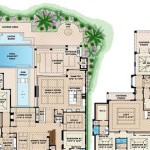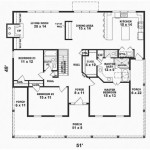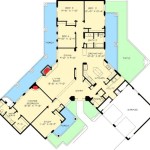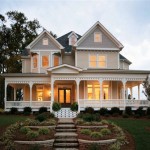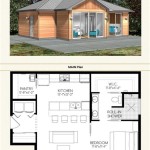Modern One Story Home Plans: A Comprehensive Overview
Modern one-story home plans are gaining increasing popularity due to their accessibility, affordability, and aesthetic appeal. These designs offer a compelling alternative to multi-story residences, catering to a diverse range of homeowners, from young families to retirees. Characterized by their horizontal emphasis and streamlined features, modern one-story homes prioritize functionality and open-concept living, often incorporating large windows and outdoor spaces to seamlessly blend the indoors with the natural environment.
This article will explore the various aspects of modern one-story home plans, including their advantages, key design elements, different styles, and considerations for choosing the right plan. Understanding these factors is essential for anyone considering building or purchasing this increasingly sought-after type of dwelling.
Accessibility and Aging in Place
One of the most significant advantages of one-story homes is their inherent accessibility. Eliminating stairs removes a major obstacle for individuals with mobility issues, making them ideal for families with young children, individuals with disabilities, and seniors planning to age in place. This accessibility translates into greater independence and reduces the risk of falls, promoting a safer and more comfortable living environment.
Beyond the absence of stairs, modern one-story home plans often incorporate other features that enhance accessibility, such as wider doorways, roll-in showers, and easily accessible storage solutions. These design choices ensure that the home remains functional and adaptable throughout the homeowner's life. Furthermore, the single-level layout simplifies maintenance and cleaning, reducing the physical strain associated with household chores.
The long-term benefits of accessibility are particularly relevant for individuals who anticipate needing assistance with mobility in the future. By investing in a one-story home, homeowners can proactively address these potential challenges and create a living space that supports their evolving needs. This foresight can contribute to a greater sense of security and peace of mind, allowing individuals to remain in their homes for longer and maintain a high quality of life.
Key Design Elements of Modern One-Story Homes
Modern one-story home plans are defined by several key design elements that contribute to their distinctive aesthetic and functional appeal. These elements include open-concept layouts, expansive glazing, low-pitched roofs, and a strong connection to the outdoors.
Open-Concept Layouts: These layouts eliminate or minimize interior walls, creating a sense of spaciousness and facilitating fluid movement between living areas. This design approach promotes social interaction and allows for greater flexibility in furniture arrangement. Open-concept layouts also maximize natural light penetration, creating a brighter and more inviting atmosphere.
Expansive Glazing: Large windows and sliding glass doors are hallmarks of modern one-story homes. These features not only provide ample natural light but also offer panoramic views of the surrounding landscape. The use of energy-efficient glazing helps to regulate temperature and minimize energy consumption. Strategically positioned windows can also create a passive solar heating effect, reducing reliance on conventional heating systems.
Low-Pitched Roofs: These roofs contribute to the horizontal emphasis of modern one-story homes, creating a sleek and contemporary profile. Low-pitched roofs are often combined with deep overhangs to provide shade and protect the building from the elements. This design element also allows for rainwater harvesting and the installation of solar panels.
Connection to the Outdoors: Modern one-story homes often feature extensive outdoor living spaces, such as patios, decks, and courtyards. These spaces extend the living area beyond the interior walls, creating a seamless transition between indoors and outdoors. The integration of landscaping and outdoor features enhances the natural beauty of the home and provides opportunities for relaxation and recreation.
These design elements work together to create modern one-story homes that are both visually appealing and functionally efficient. The emphasis on simplicity, clean lines, and natural light creates a sense of serenity and tranquility, making these homes ideal for those seeking a relaxed and comfortable living environment.
Styles and Variations in Modern One-Story Home Plans
While all modern one-story home plans share certain characteristics, there is significant variation in style and design details. These variations allow homeowners to choose a plan that reflects their personal preferences and complements the architectural context of their neighborhood. Some popular styles include contemporary, minimalist, mid-century modern, and farmhouse modern.
Contemporary: Contemporary modern one-story homes are characterized by clean lines, geometric shapes, and a focus on functionality. They often feature asymmetrical designs and a mix of materials, such as wood, metal, and concrete. Contemporary homes prioritize energy efficiency and sustainability, incorporating features such as solar panels, rainwater harvesting systems, and smart home technology.
Minimalist: Minimalist one-story homes emphasize simplicity and functionality. They feature a limited palette of materials and colors, with a focus on clean lines and uncluttered spaces. Minimalist homes prioritize natural light and ventilation, creating a sense of calm and tranquility. They often incorporate built-in storage solutions to maximize space and minimize clutter.
Mid-Century Modern: Mid-century modern one-story homes draw inspiration from the design aesthetic of the 1950s and 1960s. They feature low-pitched roofs, expansive glazing, and a strong connection to the outdoors. Mid-century modern homes often incorporate natural materials, such as wood and stone, and feature bold colors and geometric patterns.
Farmhouse Modern: Farmhouse modern one-story homes blend traditional farmhouse elements with modern design principles. They feature gabled roofs, covered porches, and natural materials, such as wood and brick. Farmhouse modern homes often incorporate open-concept layouts and large windows, creating a bright and airy atmosphere. They prioritize comfort and functionality, with a focus on family-friendly living.
These are just a few examples of the many styles and variations available in modern one-story home plans. Homeowners can work with architects and designers to customize these plans to suit their specific needs and preferences, creating a home that is both beautiful and functional.
Considerations for Choosing a Modern One-Story Home Plan
Choosing the right modern one-story home plan requires careful consideration of various factors, including budget, lot size, lifestyle, and future needs. A thorough assessment of these factors will help homeowners select a plan that meets their requirements and maximizes their investment.
Budget: The cost of building a modern one-story home can vary significantly depending on the size, materials, and finishes. It is essential to establish a realistic budget and stick to it throughout the design and construction process. Consider the cost of land, permits, materials, labor, and landscaping when developing the budget. Obtaining multiple quotes from contractors and suppliers can help to ensure that the project stays within budget.
Lot Size: The size and shape of the lot will influence the design of the home. A larger lot will allow for a more expansive design, while a smaller lot may require a more compact layout. Consider the setback requirements, easements, and other restrictions that may apply to the lot. A topographical survey can help to identify any challenges, such as slopes or drainage issues, that may affect the construction process.
Lifestyle: The home should be designed to accommodate the homeowner's lifestyle and activities. Consider the number of bedrooms and bathrooms needed, the size of the living areas, and the need for specialized spaces, such as a home office, gym, or hobby room. Think about how the home will be used for entertaining, relaxing, and working from home. A well-designed home will enhance the homeowner's quality of life and provide a comfortable and functional living environment.
Future Needs: Consider the potential for changes in lifestyle and needs over time. Will the home need to accommodate growing children, aging parents, or future mobility issues? Incorporating universal design principles can make the home more accessible and adaptable to changing needs. Consider the potential for adding on to the home in the future, if necessary. A thoughtful approach to planning for the future can help to ensure that the home remains functional and adaptable for years to come.
In addition to these factors, it is essential to work with experienced architects and builders who understand the principles of modern design and construction. They can provide valuable guidance and expertise throughout the design and construction process, helping to ensure that the home is built to the highest standards of quality and craftsmanship.
Modern one-story home plans offer a compelling combination of accessibility, functionality, and aesthetic appeal. By carefully considering the various factors involved in choosing a plan, homeowners can create a living space that meets their needs and enhances their quality of life.

One Story Modern Houses Style And Comfortable To Live

1 Story House Plans One Modern Luxury Home Floor

Modern One Story House Plot 20x17 Meter With 2 Beds Pro Home Decors 7bc

Ramble On House Plan One Story Modern Home Design Mm 2270

1 Story Modern Minimalist House Design

Silk House Plan One Story Modern Dual Suite Affordable Home Design Mm 1439 S

1 Story Modern Style House Plan Sunset Ridge

Aviator House Plan One Story Modern Home Design Mm 1199

House Plan 1 Bedrooms 5 Bathrooms 3297 Drummond Plans

Modern House Plans Floor Designs Layouts Houseplans Com


